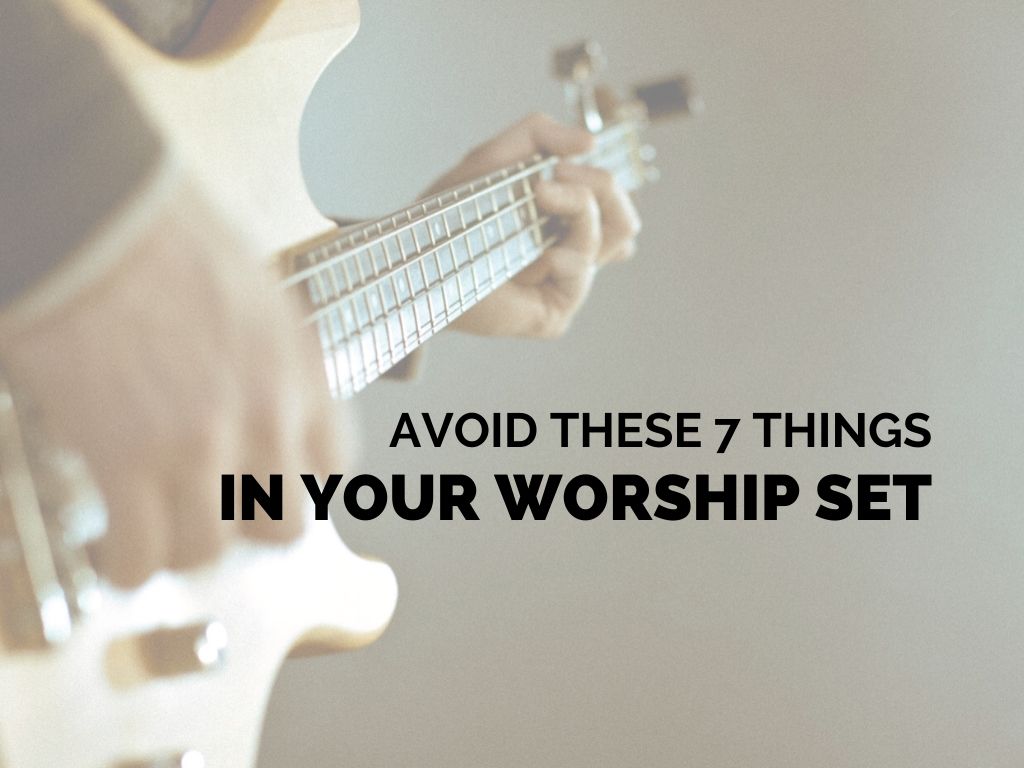Worship is the whole of your church service, yet the music tends to be the focus when we use the term, ‘worship.’ Many worship leaders and music directors understand the fundamentals of worship as a whole, and most have significant musical training. Yet, there may be some major issues with many worship sets you may encounter. If done, these issues tend to throw off your congregation.
That said, here are seven things to avoid in your Sunday church worship set:
#1 – Avoid Playing Songs in Keys That Average People Can't Sing in
One of my worship mentors always said: ‘keep the musical key from C to shining C.’ The main melody needs to fall within these notes: middle C and the C one octave above is the range in which most people can sing. We all love Chris Tomlin and Phil Wickham, but these guys have higher tenor male voices. Us ladies can’t sing in the same key, and most men can’t either. If you are a worship leader with a higher tenor voice, please do your best to sing in a lower key. Have another worship leader lead out on songs in keys that match up to the majority vocal range.
# 2 – Avoid Making People Feel Stupid When You Sing a New Song
The goal of worship is for people to unite in voice to usher in the presence of God and to draw closer to God through corporate worship. This doesn’t happen if you sing a new song, because no one will know it. A brief word of introduction from the stage can help to share why the song was selected. Further, worship leaders can even teach the chorus and invite everyone to join in. Then restart the song from the beginning after introducing it to the congregation. If nothing is said, often people don’t/can’t sing. They look around wondering if they’re the only ones who don’t know the tune.
#3 – Avoid Overly Loud Sound Production
The trend today is to create a concert environment for churches that produce modern worship sets. It’s easy to adopt the overly loud, ‘you might need earplugs’, Sunday morning worship experience, but it’s a mistake. While some people feel self-conscious about singing in a quiet church environment, it’s equally disconcerting to not be able to hear yourself sing over the loudspeakers. Your congregation will be encouraged and feel the joy of participating in communal worship when they can hear one another lifting their voices in praise for the one true God.
#4 – Avoid Selecting Songs With Lots of Repetitive Choruses and Little to no Theological Instruction
There are a plethora of empty worship songs that barely resemble sacred music out there to choose from. Please avoid these! Many excellent Bible-focused churches are writing new music each year, such as Elevation Worship. These lyrics are rich with doctrine while also being current in sound and structure. Don’t sacrifice function for form, and vice versa. Maintaining a high standard of God/Jesus-focused theology in the lyrics is vital to growing a confident and theologically sound congregation.
#5 – Avoid Mediocre Musicians
Your church might be small and not have many musicians to choose from. On the other hand, it might be large and have a large pool of talented artists. Either way, it’s important to stress technical accuracy while building a team of people who have the heart to serve the Lord in this way. Being on a worship team is a huge commitment, often including multiple hours of personal practice, plus team rehearsals on a weeknight and a Sunday morning. Although the bar should be set high, leave room for training up leaders within your congregation. Part of your role as worship director is to train leaders within your church, and this take dedication and time.
#6 – Avoid Making Everyone Stand Indefinitely
At a liturgical church, there often can be many ups and downs. Call to worship, several hymns, prayer and scripture reading, another hymn…there are natural opportunities to sit and stand. In modern church services, oftentimes there is an exceedingly long opening worship set that can span 20-30 minutes of standing. While the spry in their 20s, 30s, and 40s might do fine with this, often the children and seniors would appreciate a break. Mixing up the opening worship set with a call to worship or special music performance where people are asked to sit can help provide variety in the business of standing and sitting.
# 7 – Avoid Lack of Variety in Song Selection
Often churches will want to set a standard for the style and type of worship songs they sing. Yet, Christendom spans over 2,000 years–that a lot of music to choose from. Seeker-focused churches might avoid traditional hymns altogether, while other churches may opt to include some older hymns in their repertoire along with an occasional Amy Grant, Hillsong, or Chris Tomlin number–plus some newer worship songs, as well.
Either way, make sure you’re not rotating the same 10 or 20 songs week after week. Most will tire of lack of variety. If over the age of 25, your members might long to sing older songs that provide meaning and depth to them. Finding a groove for your church and being open to adding or subtracting songs is key. Sometimes a song needs to ‘be put out to pasture’ – it has run its course. Other times, you have a few ‘worship staples’ that have special meaning to your church.
At the end of the day, ‘going back to the heart of worship,’ as dear Michael W. Smith advises, is crucial to having a thriving, engaged, joyful church community intent of loving God through worship together.








This is an excellent article. Thank you.
I would say not just selecting songs or keys outside the comfort range of the folks but also selecting songs with that octave jump. Lots of especially MALE worship leaders with that high tenor voice will do that — start low where the men can sing and many women cannot, then jumping an entire octave. Yes. It does build emotion — but at what cost? The males aren’t gonna be able to reach that octave in the female alto-mezzo range, and the females, if they were singing an octave above the male leader since they couldn’t hit the low notes, are now going to either screech it out an octave above, or then stay where they were. And for worship song writers, JUST QUIT DOING THAT!
Hi Heather, I agree. There are lots of really emotional great new worship songs, but the octave jump is super impossible to broach when singing congregational songs. Sometimes I see the male leader starting, then switching lead vocals to the female leader for the octave jump. While the singers on stage get all the notes right, it’s super tough to get the congregation singing. One option might be to select a song with an octave jump for communion or a special music number during offering, etc. so that people can enjoy the emotive quality of the song but not be required to sing it. Blessings, Lauren